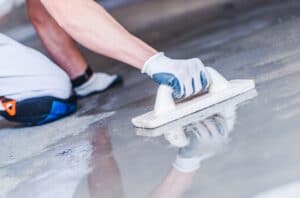A Guide to Choosing The Right Grout

It happens all the time. You’re keen to start doing some DIY tiling, but you’ve realised that you actually don’t know anything about grout
Yet grout plays a very important role when you’re tiling. It doesn’t just affect the look of your design, but the longevity and the durability of your tiles too. It’s always important to choose the right grout for the job, so knowing more about what’s out there will go a long way.
Here’s what you should know before choosing a grout:
What are the different types of grout to choose from?
There are a few types of grout out there, but for DIY, there are only really two you need to know about: cementitious grout and epoxy grout. They have different pros and cons, although our favourite is probably epoxy. Here’s the difference:
1. Cementitious Grout: Sanded or Unsanded
As the name suggests, cementitious grouts use cement as a key component. This is the traditional form of grout, and it generally comes in a packet that you mix with water before applying. Cementitious grout is cheaper than epoxy and comes either sanded or unsanded.
Sanded grout is better for wider gaps (⅛ inch wider or more) as it has better holding power and doesn’t shrink after applying. However, the abrasive bits of sand in sanded grout can scratch polished tile surfaces during installation if you’re not careful.
Unsanded grout is recommended for thin gaps only (less than ⅛ inch) as it’s not as durable as sanded grout and will crack easier in wider gaps. However, it’s easier to apply into those small, fiddly little gaps as it shrinks after application. Generally speaking, we’d recommend sanded grout for floor tiles and unsanded grout for wall tiles.
2. Epoxy Grout
A more modern form of grout, Epoxy doesn’t use cement or water at all. Instead, it’s made of epoxy resin, as well as silica fillers, pigments and a hardening component
There are a lot of benefits to using epoxy instead of cementitious grout. It’s harder, it’s more resistant to moisture, stains and mould, and it doesn’t usually require sealant. For these reasons, we prefer epoxy to cementitious grout almost every time, especially in bathrooms where cement grout will start to show wear and tear quickly.
The downside for DIY-ers is that it sets much faster and the consistency of epoxy is a little harder to handle, so you might struggle to install it properly if you don’t know what you’re doing. It’s also considerably more expensive than cement grout, but you’ll save more money over time because it requires much less maintenance.
Choosing a grout colour
Colour is a huge consideration when you’re choosing grout. Generally, you’re going to want to pick a neutral colour or a colour that’s a shade more subtle than your tile colour. Some companies even offer clear or translucent grouts. If you can, matching your grout colour to the tile colour will likely give you the best results.
Some people might recommend choosing a dark grout to hide stains and dirt. We don’t recommend this, at least not for this reason. Paired with the wrong colour, grout that is darker than your tile simply looks dirty, and it will only get darker over time.
You’ll also struggle more with grout haze during installation, which could leave unsightly stains on your tiles. However, don’t be afraid to go with dark grout if you’re after a contrasting look. This is pretty trendy right now when done right, especially with subway tiles and splashbacks.
It’s worth noting that lighter grouts will show stains as well if you don’t look after them and clean regularly. Using an epoxy grout is a good idea if you want to avoid stains, as it seals over smoothly like plastic, and doesn’t become porous over time the way that cementitious grout does.
The type of grout you use will also affect the colours you can choose. Unsanded grouts generally have the least choice, while sanded grouts have a good range available. Epoxy grout generally offers the most choice, with some really interesting options now available, like translucent glass grout, sparkling grout or even glow-in-the-dark.
Choosing sealant for your grout
Sealing is very important. You need to seal your cementitious grout to stop moisture from getting in, which can cause dangerous mould to grow and damage your tile adhesive. Epoxy grouts have yet another advantage here because they generally come pre-sealed and won’t require you to do any extra sealing
There are two types of sealant available for cementitious grouts – membrane sealers and penetrating sealers. Membrane sealants are a bit cheaper, but they break down with age. We recommend choosing a penetrating sealant, which soaks all the way through the grout and creates a longer-lasting seal.
For best results, your grout will need to be resealed every few years. Note that resealing is different to a full regrout – it’s not a big job and you should try to stay on top of it.
If you’re installing unglazed tiles, you need to seal them with a glaze before applying your grout. If you put it over the top of your grout, the tile sealant will prevent the grout from properly adhering or penetrating into the tile, and you’ll have wasted your time.
Some other important tips to keep in mind
Finally, here is some of the general grout wisdom we’ve picked up over the years. The first is the general lifespan of grout – expect to go 15-20 years between regrouts and potentially longer with quality epoxy grouts.
Another thing to consider is grout haze, which is the fine dust that gets everywhere while you’re installing your grout. This dust can pose a big problem with porous tiles like quarry tiles or limestone tiles, which will easily stain. Epoxy haze is less severe than cementitious haze, but it can dull the look of polished tiles if you don’t clean it up quickly.
When you’re cleaning up grout haze, we recommend using a dry towel after your first wet mop dries. Getting it wet a second time will turn it into mud again and start a vicious cycle of creating more mess every time you try to clean it.
Also, make sure the area you’re regrouting is well ventilated, and if you’ve got any N95 masks leftover from COVID, it’s a good idea to wear one. Epoxy grouts and cementitious grouts both contain fine toxic particles that can cause respiratory problems if you inhale too much of the haze.
Finally, while installing grout is a fun DIY project to take on yourself, regrouting can be a bit of a pain in the ass, to put it bluntly. Scraping out the old grout to add the new grout is real grunt work, and just slapping it right over the top instead can cause sealing problems down the line. A small room or wall will be fine to do on your own, but consider calling a professional for big regrouting jobs.
Hopefully, this quick guide to grout has given you a better understanding of the stuff. Grout is an important part of tiling and we’ll be posting more in the future about how to work with it.
Meanwhile, why not check out the huge range of grouts at Multifors? We’re an online hardware marketplace, and we take care to only stock the highest quality products at great prices. Delivery across Metro Melbourne from $19.95
-
 11, Jul, 2022
11, Jul, 2022Feature Product: The Stain Proof Range
We regularly review some of our favourite products. Today, we’re... -
 5, Jul, 2022
5, Jul, 2022Concrete Sealer: What You Need to Know
Concrete is a sturdy material that’s practical and affordable. In... -
 24, Jun, 2022
24, Jun, 2022A Product Guide for DIY Pool Areas
Tiling a pool area is a great DIY project. In...


